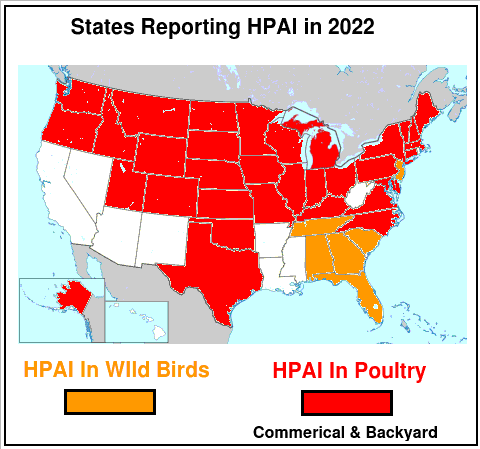#16,736
In 2015 - the last time we saw an avian H5 epizootic - only 15 states were affected, but as the map above illustrates, this year's outbreak covers nearly the entire country. Poultry losses aren't quite as high as they were 7 years ago - likely due to better biosecurity, particularly among commercial farms - but this outbreak is far from over.
Unlike the last time avian flu visited North America, the Eurasian HPAI H5 virus is now considered to pose a small zoonotic threat. We've seen 1 probable human infection here in the United States (and one in the UK), both which were described as `mild'.
The current threat to human health, however, is considered very low, and the biggest concern is this epizootic's impact on poultry and wild birds.
On Friday the USDA announced two more states had detected HPAI H5 in backyard flocks (see below).
USDA Confirms Highly Pathogenic Avian Influenza in Oregon and Washington
Published: May 6, 2022
Contacts:
APHISpress@usda.gov
WASHINGTON, D.C., May 6, 2022 – The United States Department of Agriculture’s (USDA) Animal and Plant Health Inspection Service (APHIS) has confirmed the presence of highly pathogenic avian influenza (HPAI) in a non-commercial, backyard flock (non-poultry) in Linn County, Oregon and a non-commercial backyard flock (poultry) in Pacific County, Washington.
Samples from the Oregon flock were tested at the Oregon State University Veterinary Diagnostic Laboratory and samples from the Washington flock were tested at the Washington Animal Disease Diagnostic Laboratory, both part of the National Animal Health Laboratory Network. The cases were confirmed at the APHIS National Veterinary Services Laboratories in Ames, Iowa.
APHIS is working closely with state animal health officials in Oregon and Washington on joint incident responses. State officials quarantined the affected premises, and birds on the properties will be depopulated to prevent the spread of the disease. Birds from the flocks will not enter the food system.
According to the U.S. Centers for Disease Control and Prevention (CDC), the public health risk associated with these avian influenza detections in birds remains low. As a reminder, the proper handling and cooking of all poultry and eggs to an internal temperature of 165 ˚F is recommended as a general food safety precaution.
The $64 question is whether HPAI will become a permanent resident in North America - or if it will disappear the same way it did after the 2015 epizootic (see PNAS: The Enigma Of Disappearing HPAI H5 In North American Migratory Waterfowl).
The HPAI H5 virus visiting us today is an ancestor of that 2015 HPAI H5Nx, but it has undergone numerous changes. In 2016 this virus reassorted - probably in Russia or China - and since then has become better adapted to long-term carriage by some types of wild birds, allowing it to spread more efficiently.
So far, we've been lucky, in that vast oceans and long distances have limited the ability of Asian and European HPAI H5 viruses to threaten North America. The concern now is these viruses will establish a foothold in North American birds, and become a perennial threat.

